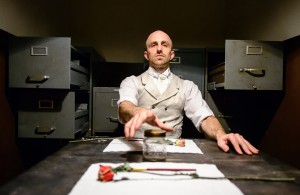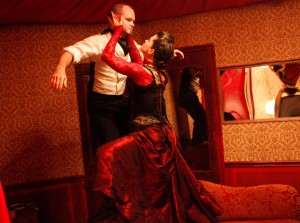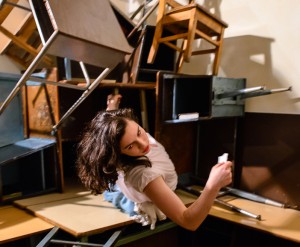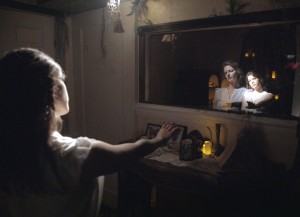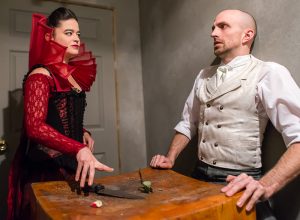GO ASK ALICE
“Do you take dictation?” the gentleman asked as he gently closed the door to the study. Seated at an antique rolltop desk, I responded with an eager “Yes,” picked up a gold pen and began to write on the notepaper he placed in front of me. “Dear Alice’¦” This man, I realized with sudden reverence and awe, must be Lewis Carroll.
Scene from Then She Fell. Photo by Rick Ochoa.
Through every door in the abandoned Kingsland Ward at St. John’s institutional facility lies an enchanting new scene inspired by Alice in Wonderland. With only fifteen audience members per performance, the immersive theatrical experience Then She Fell sends its participants spiraling down the rabbit hole and stepping through the looking glass to a magical world that plays on the borders between fantasy and reality, madness and sanity, youth and adulthood.
Comparisons to Sleep No More, the Macbeth-inspired dance theater piece in residency at the McKittrick Hotel, are inevitable – but Third Rail Projects’ Then She Fell is a distinctive and decidedly more intimate piece. Characters from Lewis Carroll’s fiction (Alice, the White Rabbit, the Mad Hatter, the Red and White Queen) intermingle with the author and his child muse Alice Liddell, not to mention the doctors, nurses, and ward staff at the institutional facility. Audience members also become active participants in the drama by taking dictation for Carroll, selecting a hat with the chatty Mad Hatter, and tasting an elixir or two (by mixologist Kathy Hubler) along the nonlinear journey.
Rather than give participants free reign of the three-floor facility, Then She Fell is a carefully guided, episodic adventure written, directed, designed, and choreographed by Zach Morris, Tom Pearson, and Jennie Willet. Characters lead audience members from one closed room to another, and each guest has a unique path; experiencing every scene would require multiple visits. Using a set of keys they are given at the beginning of the performance, audience members are encouraged to explore the stunningly detailed space by digging through drawers of old correspondence, boxes of photographs, and cupboards covered with theories of time – until a character or two enters to perform a scene.
The choreography and movement can leave something to be desired; the scenes with the Red Queen grow especially repetitious. Yet the manipulation of perspective and the use of space is ever imaginative, and the intimate (and often one-on-one) scenes are wondrous. Locking eyes with the actors and organically coming to an understanding of my purpose in each scene was one of the most magical pleasures of the show. I uncorked a fruity potion to drink with Alice, then watched her “grow” to the ceiling by propelling herself up a stack of upturned school desks. I was mesmerized by the experience of lying down on a hospital bed to hear the White Queen tell a bedtime story.
While I lay on the bed with the moonlight shining in and the sound of footsteps echoing from the busy hallway outside, I realized that Then She Fell was enabling me to play and to dream in a way I hadn’t since I was a child. Although I had been self-conscious at first, I quickly found myself improvising along with the company. Like the unique friendship between Lewis Carroll and his child muse Alice, Then She Fell breaks down age barriers and welcomes the audience into a luminous, collective fantasy. I am already crossing my fingers for a seat at the Mad Hatter’s tea party on my next adventure in Wonderland.
photos by Chad Heird and Darial Sneed and Rick Ochoa
Then She Fell
Third Rail Projects in collaboration with The Company
Kingsland Ward at St. Johns
195 Maujer Street in Williamsburg, Brooklyn
open run CLOSED due to COVID-19 after seven and a half years and 4,444 performances
for more info, visit Then She Fell

